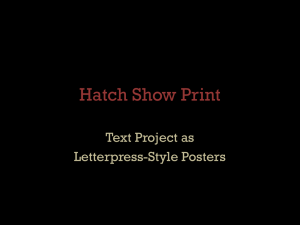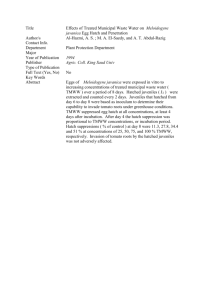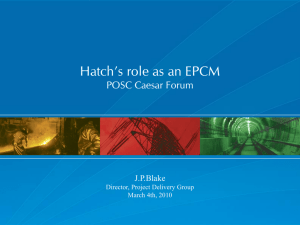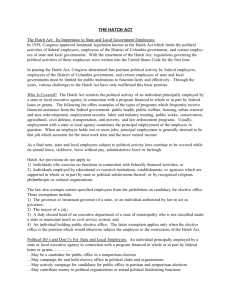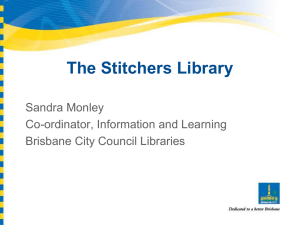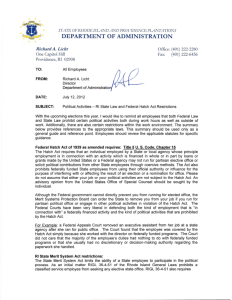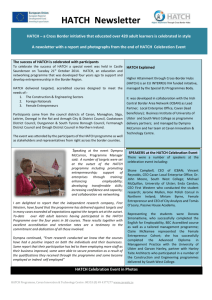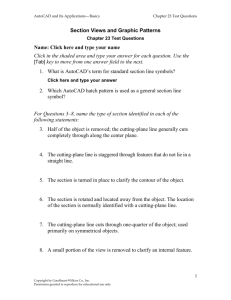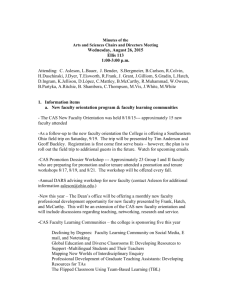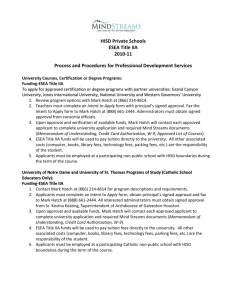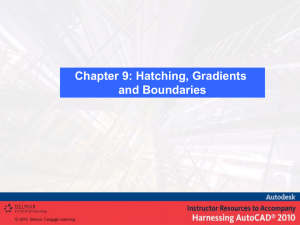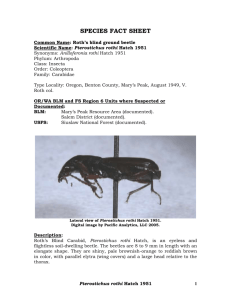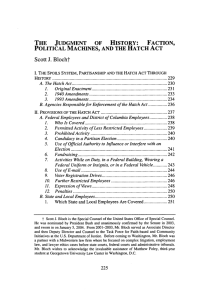My View of Why We Study Organization Theory
advertisement
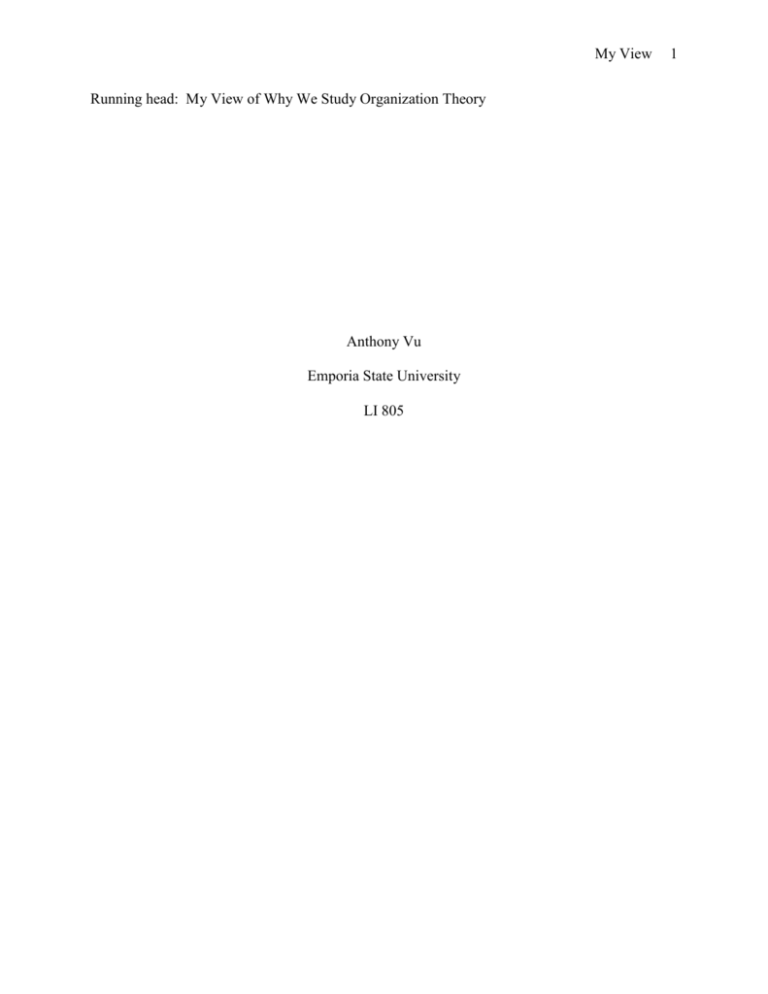
My View Running head: My View of Why We Study Organization Theory Anthony Vu Emporia State University LI 805 1 My View Abstract Even though the author presented the modern, symbolic and postmodern perspectives, this paper is an overview of why I study organization theory in application more toward a modern perspective. 2 My View 3 According to Hatch (p. 3), to convince people to study and understand organization theory is not an easy persuasion because the subject tends to be dry and perhaps boring. At the conclusion of my LI805 class, Dr. Lillard had turned this dry, boring subject into a wonderful and fun learning experience. Before this class, my comprehension of organization theory was just on the peripheral surface. Now, I have a deeper understanding and an appreciation for why we need to study organization theory. As an introduction to the class, we all have to define what is an organization? I like the definition found on Wikipedia: “An organization is a social arrangement which pursues collective goals, which controls its own performance, and which has a boundary separating it from its environment.” We all belong to some type of organization one way or the other; whether it is at work, church, sports team, school, or our own family, these are just a few examples of an organization that we can define ourselves belonging to. I feel that organization exist to keep social order and to prevent anarchy. Roy H. Autry, MBA, Ph.D, who wrote the article “What is Organization Design?” said that “people choose to organize when they recognized that by acting alone they are limited in their ability to achieve. We sense that by acting in concert we may overcome our individual limitations.” Autry statement makes so much sense when I reflect upon many group assignments and group activities that were presented in LI805 class. In a sense, belonging to a group in class is like being in an organization itself. Hatch listed areas where organization theory can be applied but not limited to such as strategy/finance, marketing, information technology, operations, human resources, and communication. (Hatch, p. 4) Through out the course of discussion on the core concepts and theories of organization, I am fascinated by and really enjoyed analyzing some of the core components of an organization My View 4 such as organizational environment, organizational social structure, technology, organizational culture, the physical structure of organizations, and the organizational power, control and conflict. In each of these components, Hatch presented the modernist view, the symbolic interpretation and the postmodern perspectives. The majority of the application used in class LI805, such as in the scenario exercise, was conceptualized through the modernist model. In the modernist view, “the organizational environment is conceptualized as an entity that lies outside the boundary of the organization, providing the organization with raw materials and other resources (inputs) and absorbing its products and services (outputs).” (Hatch, p. 63) Therefore the perplexing part of analyzing an organizational’s environment is identifying where the organizational boundary lies. (Hatch, p. 63) “Every organization consists of social elements including people, their positions within the organization and the groups or units to which they belong.” (Hatch, p. 134) The relationship and the positions of individuals within the organization define the social structure of an organization. The social structure includes the hierarchical structure and the complexity of the organization such as the size of the organization and the communication channels. The activities and processes that take place within the organization that helps distinguish an organization are defined by the core technology. The physical object and artifacts that are necessary for the organization to operate its business are the components that attributes to the core technology. I found that Hatch’s chapter on technology seems to be dull and boring even though its application is useful in contributing to the core concept of an organization. The next core concept is the most fascinating and intriguing chapter--the organizational culture. There are a few selected definitions of organizational culture, but the one that appear to be more applicable to the social norm is by John Van Maanen: My View 5 Culture refers to the knowledge members of a given group are thought to more or less share; knowledge of the sort that is said to inform, embed, shape, and account for the routine and not-so-routine activities of the members of the culture….A culture is expressed (or constituted) only through the actions and words of its members and must be interpreted by, not given to, a fieldworker….Culture is not itself visible, but is made visible only through its representation. (Hatch, p. 177) The intriguing thing about organizational culture is that most of us can identify the peripheral layer of an organization. For example, let’s take this core component and apply to the content of the movie we watched in class, like The Firm. We can see the appropriate attires of the people at a prestigious law firm; the family members at the firm’s social gathering from the wives to the parents and the kids; the house and the fancy car, and appropriate rules and regulation endorsed by the firm was addressed by the mentor to the new employee. Within the content of the organizational culture, there is subculture. Subculture “is a subset of an organization’s members that identify themselves as a distinct group within the organization and routinely take action on the basis of their unique collective understanding.” (Hatch, p. 176) The movie Ants shows the subculture of the worker ants and issues that involves the context of individualism versus collectivism, and masculine versus feminine. Individualism versus collectivism “involves the degree to which individuals in a culture are expected to act independently of other members of the society.” (Hatch, p. 184) The movie Ants displayed an organization with a hierarchical structure; from the king, queen, the general, soldier ants, and workers ants. Here you have an individual ant who wants to break away from his totalitarian society and win the heart of the princess he loves. Masculine versus feminine “refers to the My View 6 degree of separation between gender roles in a society.” (Hatch, p. 184) We can see this degree of separation in the role of all the wives at the social gathering in the movie The Firm. The next core concept is the physical structure of organizations. This concept is pretty much straight forward. It is the physical structures that identifies, represents, or displays an organization such as: the architectural design of a church, school, museum, government office, law firm, or an arena for a sports team. These are just a few examples. The “physical elements of organizational structure and their relationships have important implications for the behavior of people who are associated with the organization including managers, employees, customers, suppliers, members of the local community and others who interact with or within the organization.” (Hatch, p. 246) The physical structure of an organization has symbolic importance and usually delivers a powerful image of that organization. The last core concept that kept my attention span intact about this subject is the organizational power, control, and conflict. “One way to think of the relationship between power, conflict and control is that conflict is a manifestation of the continuous struggle over control that power relations imply.” (Hatch, p. 251) The movie The Twelve Angry Men displays all the content of this core concept. As a matter of fact, this movie did a good job of displaying the six core concepts that makes up the content of organization theory, and from the hostile environment to conflicts that arises thru individualism versus collectivism. There was struggle to gain leadership within the twelve jurors and the rise of one man-Henry Fonda, that influence individuality which in return influence the whole group to reach one goal-the same goal, and this my friend is how a successful organization work! So the conclude question is why do I need or perhaps to say want to study organization theory? Hatch (p. 16) states that her reason for studying organization theory is to “broaden my My View 7 perspective on organizations and the world in general and open my mind to new ideas and possibilities for change and transformation.” For me, studying organization theory gives me a deeper appreciation on the complexity of certain organizations and what it takes for these organizations to be successful. But I think the most influence is that organization theory broadens my horizon on how to assess my individualism and see where I would fit in an organization. Before I had taken this class, my perception of organization theory was studies that focused on groups. But after taken this class, I was surprised at how the theory also focused on the individuality within an organization. This focus on individuality helps me to reevaluate myself in pursuing my career, and to see how well I work with others in my field. For example, should I work at reference, cataloging, or be an archivist. Which organizational environment would I fit in and how my assets would help strengthen that organization? These are a few questions that came into my perspective at the conclusion of class LI805. My View References Autry, Roy H. (1996). What is Organization Design? http://www.inovus.com/organiza.htm. Hatch, Mary Jo., & Cunliffe, Ann L. (2006). Organization Theory (2nd Ed.). Oxford University Press Inc. 8

